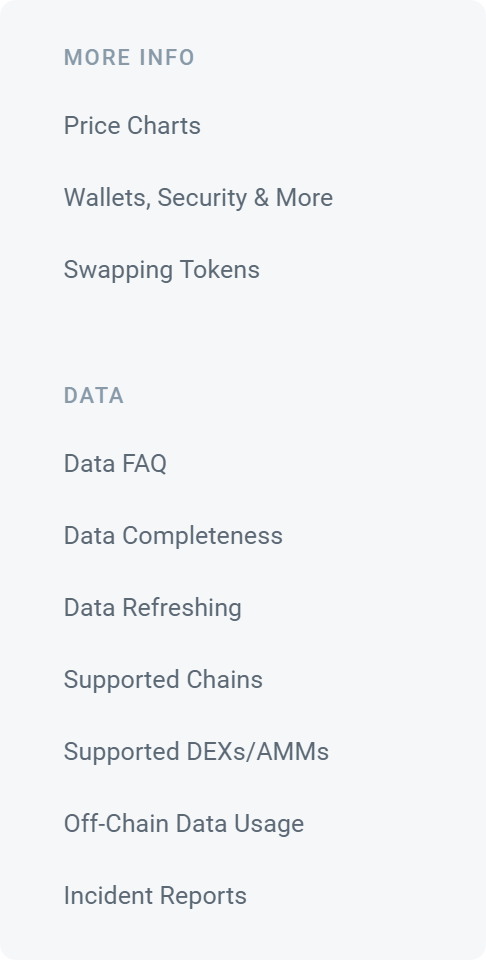One of the initiatives that we have been working on a lot recently was understanding how we could incorporate data transparency as as one of our guiding principles when building DexGuru.
In understanding why this was important, we need to quickly revisit why we built DexGuru in the first place - our goal was to equip the everyday crypto native user with an easy-to-use powerful analytical toolkit that also had trading capabilities. We wanted to make sure we could enable anyone to make sense of the endless streams of blockchain data out there, allowing users to make better and more informed decisions.
But what we realized was that, our product would only be as good as the integrity of the data we had and displayed. And for us to earn and expect users to trust DexGuru, it only made sense that we had to make a conscious effort in being transparent and informative about all aspects regarding our data. This included things such as where the data came from/sourced, scope of data, data availability, data timeliness & etc - that way as an end user, you’ll always know the entire picture of the data you’re seeing from start to finish.
And after all, the great thing is about transparency is that our strengths and advantages are on show but also our limitations are out there, keeping us publicly accountable and nudging us to continually improve on the quality, speed and scope of the data we have.
Since kicking off this initiative, here’s what we’ve achieved so far:
Revamped all DexGuru Documentation & Created Data Specific Sections
The first place we started was with our external Gitbook documentation. Admittedly, we previously hadn’t spent as much effort and time as we needed to as we were more focused on building our core product at the time. But what we knew that our documentation was also an extension of our product and platform itself, and we needed to do better.
As a result, we have improved it significantly by updating existing information, adding new sections including an entire section dedicated to everything about data on DexGuru. From how we calculate it, where it comes from/sourced, the type of data we have, the data that is available (including Chains & DEXs/AMMS supported) - Essentially, any questions our community and users may come across regarding our data, we hoped to have it all answered here.

And more recently, we’ve also added a new page called Incident Reports where we post retroactive reports on any Data related incidents that have occurred previously. This way, if there’s any issues, you’ll know exactly what happened, what we’ve done to resolve it and to ensure it doesn’t occur again.
Building Data Transparency into Product & Feature Design
The next step was understanding how we could build data transparency directly into our products and features natively, especially where it was necessary and could provide additional context to the user’s experience. From this, we landed and implemented two improvements to our product:
Data Disclaimer with our Network Node Statuses
Another data related principle we follow is striving to always use on-chain data as much as we can due to its immutable, secure and final properties (which is why we disclose all our Off-Chain Data Usage!) and as a result, we have invested heavily in our data infrastructure by setting up and maintaining our own Blockchain Network nodes.
All of our transaction data comes directly from these nodes, and we launched a Data Disclaimer that provides you real time status updates of our blockchain nodes. Now you’re able to access this directly from our footer and see in real time, the node status, latest blocks and timestamps that our nodes have retrieved and updated on the DexGuru platform. This allows you to know exactly how recent and updated our data is, along with real reports of any possible outages.
Added Countdown Timers for Transaction List Updates
In an ideal world, we’d love to feed every single transaction as it happens for completely instant updates but due to some technical constraints that currently prevent us doing so, we batch update transactions in small intervals to optimize for loading speed.
Previously, these time intervals where data was being retrieved from the blockchains were not so obvious to our users. So we’ve made a conscious product decision in letting users know exactly when the next batch of transactions will be refreshed, that way you know exactly the timeliness of the data that you are currently looking at and make decisions accordingly.
Looking ahead and building forward
As we continues to grow and build out DexGuru, we’ve made sure that we continue to be guided by the best practices surrounding our data and being transparent about them. This wasn’t just an one-off project that we wanted to tackle and let it sit on the sidelines.
We’ve also invested considerably time improving our internal processes, checklist and documentations to ensure that any changes in our data will be swiftly communicated to our community and users. And of course, moving forward the way we approach and think about our Product, Design & Feature development will incorporate these very same principles of data transparency.



